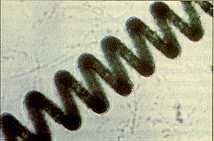What Is Spirulina
Spirulina's Nutritional Analysis
How Spirulina Is Produced
Spirulina Research References
Products Containing Spirulina
Guardian Greens
Green Magic

What Is Spirulina
 Spirulina is a blue-green algae. Spirulina is a simple, one-celled form of algae that thrives in warm, alkaline fresh-water bodies. The name "spirulina" is derived from the Latin word for "helix" or "spiral"; denoting the physical configuration of the organism when it forms swirling, microscopic strands.
Spirulina is a blue-green algae. Spirulina is a simple, one-celled form of algae that thrives in warm, alkaline fresh-water bodies. The name "spirulina" is derived from the Latin word for "helix" or "spiral"; denoting the physical configuration of the organism when it forms swirling, microscopic strands.
Spirulina is being developed as the "food of the future" because of its amazing ability to synthesize high-quality concentrated food more efficiently than any other algae. Most notably, spirulina is about 60 percent complete protein, with all essential amino acids in perfect balance. In comparison, beef is only 22 percent protein.
Spirulina has a photosynthetic conversion rate of 8 to 10 percent, compared to only 3 percent in such land-growing plants as soybeans.
In addition, spirulina is one of the few plant sources of vitamin B12, usually found only in animal tissues. A teaspoon of spirulina supplies 2 1/2 times the Recommended Daily Allowance of vitamin B12 and contains approximately the same amount of this vitamin's human available form as found in an equivalent serving of beef liver.
Spirulina also provides high concentrations of many other nutrients - amino acids, chelated minerals, pigmentations, rhamnose sugars (complex natural plant sugars), trace elements, enzymes - that are in an easily assimilable form. Spirulina is one of the richest beta-carotene foods with ten times more concentrated beta-carotenes than carrots.
Even though it is single-celled, spirulina is relatively large, attaining sizes of 0.5 millimeters in length. This is about 100 times the size of most other algae, which makes some individual spirulina cells visible to the naked eye. Furthermore, the prolific reproductive capacity of the cells and their proclivity to adhere in colonies makes spirulina a large and easily gathered plant mass.
The algae are differentiated according to predominating colorations, and are divided into blue-green, green, red, and brown. Spirulina is one of the blue-green algae due to the presence of both chlorophyll (green) and phycocyanin (blue) pigments in its cellular structure.
Even though spirulina is distantly related to the kelp algae, it is not a sea plant. However, the fresh-water ponds and lakes spirulina favors are notably more alkaline, in the range of 8 to 11 pH, than ordinary lakes and cannot sustain any other forms of microorganisms. In addition, spirulina thrives in very warm waters of 32 to 45 degrees C (approximately 85 to 112 degrees F), and has even survived in temperatures of 60 degrees C (140 degrees F).
Certain desert-adapted species will survive when their pond habitats evaporate in the intense sun, drying to a dormant state on rocks as hot as 70 degrees Centigrade (160 degrees F). In this dormant condition, the naturally blue-green algae turns a frosted white and develops a sweet flavor as its 71 percent protein structure is transformed into polysaccharide sugars by the heat.
Some scientists speculate that the "manna" of the wandering Israelites, which appeared miraculously on rocks following a devastating dry spell and was described as tasting "like wafers made with honey " may have been a form of dried, dormant spirulina.
This ability of spirulina to grow in hot and alkaline environments ensures its hygienic status, as no other organisms can survive to pollute the waters in which this algae thrives. Unlike the stereotypical association of microorganisms with "germs" and "scum", spirulina is in fact one of the cleanest, most naturally sterile foods found in nature.
Its adaptation to heat also assures that spirulina retains its nutritional value when subject to high temperatures during processing and shelf storage, unlike many plant foods that rapidly deteriorate at high temperatures.
Spirulina is also unusual among algae because it is a "nuclear plant", meaning it is on the developmental cusp between plants and animals. It is considered somewhat above plants because it does not have the hard cellulose membranes characteristic of plant cells, nor does it have a well-defined nucleus. Yet spirulina's metabolic system is based on photosynthesis, a process of direct food energy production utilizing sunlight and chlorophyll, which is typical of plant life forms.
In essence, Spirulina straddles that fork in evolutionary development when the plant and animal kingdoms differentiated. Thus spirulina embodies the simplest form of life. In contrast, other algae such as Chlorella have developed the hard indigestible walls characteristic of plants.